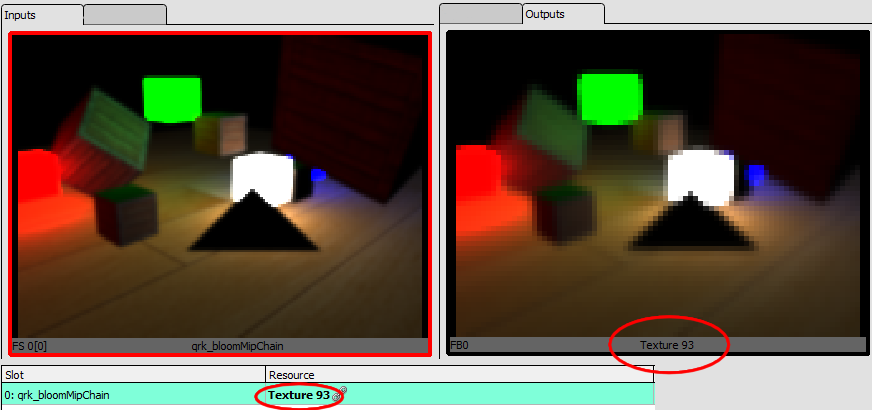OpenGL Texture Mip Targeting
#6A while back, I was implementing a bloom post process effect for my personal renderer project, and I ran into an interesting hurdle involving how texture samplers and framebuffers work in OpenGL.
A pretty common technique used by several engines involves repeated downsamples of the final (HDR) frame using a specialized blur kernel, and then a series of upsamples in reverse that accumulate the blurred textures, resulting in a nice and natural-looking bloom effect after tone mapping.
Nowadays, you’d probably want to just use compute shaders to generate your bloom texture, but if your target API was older than OpenGL 4.3, compute shaders wouldn’t be available. So, I wanted to try building it with just standard framebuffers and direct dispatch.
The problem #
Commonly, bloom implementations like this would use multiple textures (at least 2) and ping-pong the downsampling and upsampling between the two to make the calls easier.
However, since the downsamples/upsamples are sequential, all you really need conceptually is a single texture with a mipmap chain, so this is what I opted for.
I initially tried using textureLod() in the fragment shader to sample from a
specific mip level (for both downsampling and upsampling) but it turns out that
if the texture filtering mode doesn’t use mipmaps (i.e. if the filtering mode is
GL_NEAREST or GL_LINEAR, instead of something like
GL_LINEAR_MIPMAP_LINEAR) then textureLod() will always sample from mip 0.
Since I was also writing to the same texture I was sampling from (just at a
different mip level), I was a bit hesitant to use the other filtering modes, but
the biggest reason to avoid this came from something I found in the OpenGL spec.
Whenever a texture is sampled from while also being rendered to, you can run the risk of hitting undefined behavior (the value of rendered fragments is undefined). This is referred to as a feedback loop. The specifics of the OpenGL spec are fairly conservative about what can trigger this, even if the shader has logic that wouldn’t actually ever sample from the same texel that it’s writing to. See the spec for details: https://registry.khronos.org/OpenGL/specs/gl/glspec40.core.pdf#page=299
The solution #
The requirements in the spec also point towards a solution: if you explicitly
set the GL_TEXTURE_BASE_LEVEL and GL_TEXTURE_MAX_LEVEL texture params
appropriately during each step of the bloom, it will be impossible for the
shader to sample from the same mip level that it’s writing to, thus avoiding the
undefined behavior. The details are as follows:
First, to select the mip level to render to, you can use
glFramebufferTexture2D, along with glViewport to set the width/height of the
mip you are rendering to.
glBindFramebuffer(GL_FRAMEBUFFER, framebufferID);
glFramebufferTexture2D(GL_FRAMEBUFFER, GL_COLOR_ATTACHMENT0, GL_TEXTURE_2D, textureID, mipmaplevelToRenderTo);
glViewport(0, 0, mipWidth, mipHeight);
Then, to limit the mip level that you’re sampling from, the safest way is to use
the GL_TEXTURE_BASE_LEVEL and GL_TEXTURE_MAX_LEVEL texture parameters.
glBindTexture(GL_TEXTURE_2D, textureID);
int mipToSampleFrom = mipmaplevelToRenderTo - 1;
glTexParameteri(GL_TEXTURE_2D, GL_TEXTURE_BASE_LEVEL, mipToSampleFrom);
glTexParameteri(GL_TEXTURE_2D, GL_TEXTURE_MAX_LEVEL, mipToSampleFrom);
In the shader, this will allow you to use a simple texture(sampler, uv) (or
similar) as normal, and it will only sample from the one mip level you
specified. Note that GL_TEXTURE_BASE_LEVEL also changes the meaning of GLSL
functions like textureSize(), which take a LOD parameter: if you’ve modified
GL_TEXTURE_BASE_LEVEL, then the LOD will be relative to the base level,
meaning that textureSize(sampler, 0) will conveniently return the size of the
currently configured base mip level.
To reset, just set those params to their default OpenGL values:
glTexParameteri(GL_TEXTURE_2D, GL_TEXTURE_BASE_LEVEL, 0);
glTexParameteri(GL_TEXTURE_2D, GL_TEXTURE_MAX_LEVEL, 1000);
This allows us to read from and write to different mip levels of a single texture with only a single framebuffer object.
